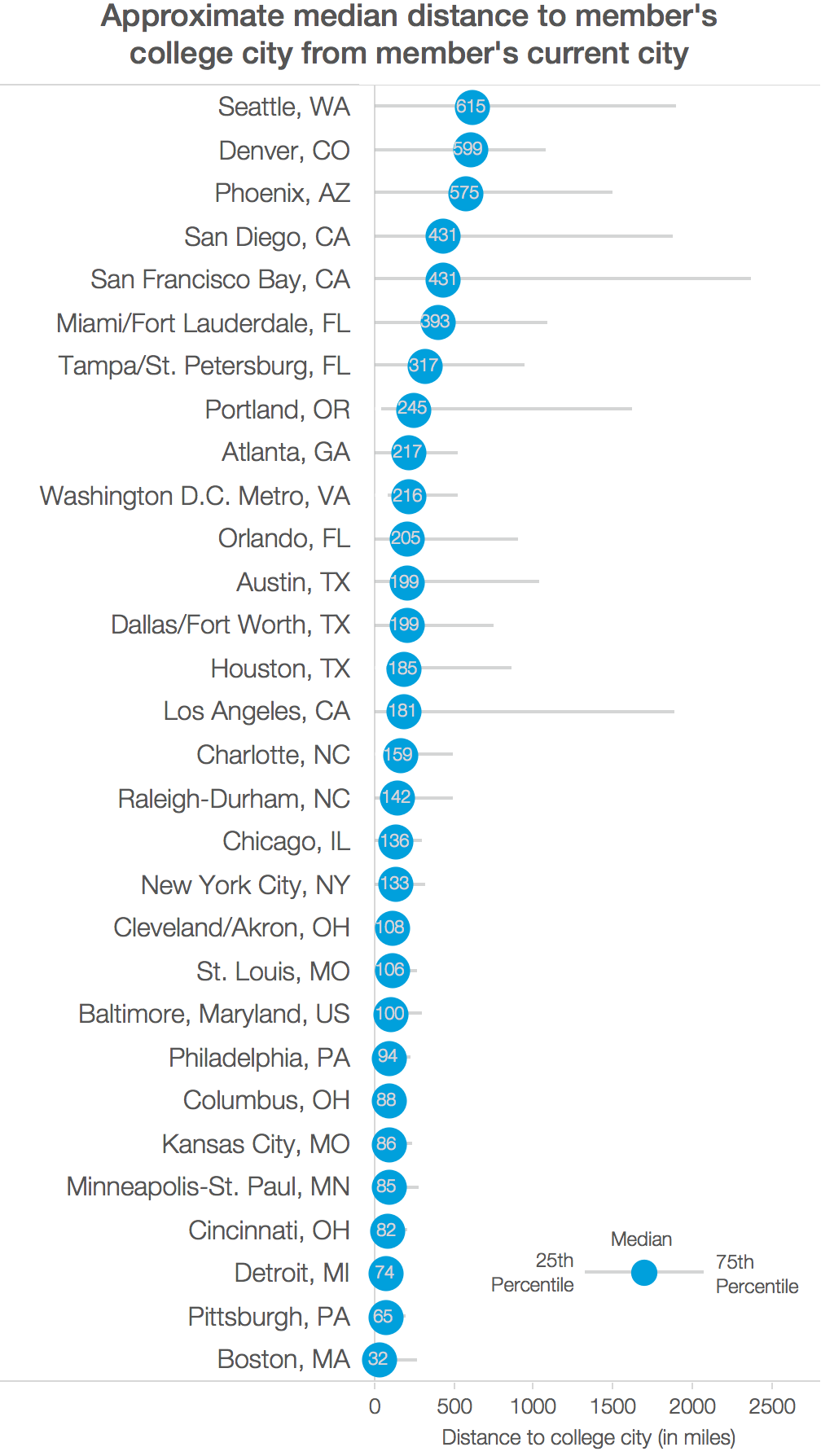Where LinkedIn members moved for work after college
May 5, 2015
Around this time of year, thousands of college students are getting ready to graduate and make their move into the workforce. This means potentially thousands of people could be relocating to a new city for a new job or internship opportunity.
While some cities are known for attracting talent from all corners of the globe, others are known for retaining graduates from local universities. Indeed, the geographic location of your college plays a part in where you may end up living and working. (Spoiler alert: If you’re graduating from a college on the east coast, pack up those winter clothes, because you’re likely to move out west!)
We estimated the distance between the city where LinkedIn members went to college to obtain their bachelor’s degree and the city they currently work. After aggregating the data, and computing the median distance for the 30 largest US cities by LinkedIn membership, the result shows us just how far members travel to get to where they’re at.

Most cities have a 25th percentile distance of zero, which is due to a large portion of members having gone to school in the city where they currently reside. The notable exceptions are Washington DC, Portland, Houston, and Charlotte. Each of these cities have large alumni bases who went to schools in adjacent towns nearby.
The 75th percentile distances tell us a lot. Geographic isolation may play a role in the rankings of Denver and Phoenix, which have high median distances, but lower 75th percentiles relative to the other cities. (Western cities tend to be more spread out than eastern cities.)
However, the huge distances reflected in the 75th percentiles of cities like San Francisco and Los Angeles indicate that they’re attracting members who went to college on the East Coast and beyond. San Francisco’s 75th percentile of ~2,400 miles tops our chart, and is roughly the distance to New York City.
Interestingly, according to LinkedIn data, the college-to-work migration trend in the US has a distinct westward bias. In other words, quite a few members who were educated in the East Coast moved West for work, while the reverse pattern isn’t as prominent. In fact, nearly three times as many members made the move from East Coast universities to jobs in San Francisco versus West Coast universities to jobs in New York City. Some of this can be explained by population distribution (more people live on the East Coast, leading to greater choice in schools to attend) but the fact remains: even in 2015 the call of the Wild West is still strong. (Or everyone got fed up with the crazy snow storms. Either way.)
While Seattle tops our list in part due to a sizeable chunk of its graduates coming from California and the Midwest, an interesting geographic quirk pushes the median distance out farther than every city on our list. It turns out that a large fraction of Seattle’s graduate population went to college in Eastern Washington and parts of Oregon, all roughly 250+ miles away.
This data can also yield some insight into the proportion of each city’s member base that is local to the area. The shorter the median distance between work and college, the greater the potential for more “local” talent. Longer median distances could suggest more “outsiders.” If you’re looking to make a move to a city where your future colleagues are likely to come from a wider variety of places, consider the cities near the top of our list.
The ultimate question of why some cities attract college educated members from all over the world while other don’t is a complicated one, and the answers are varied and nuanced which can’t be adequately addressed in this post. The industries in these regions, the jobs they generate, and the skillsets they require can all play a role in determining the people they attract. For example, Denver and San Diego are hubs for geological and life sciences, respectively, while Phoenix offers a lot of opportunities for business services like customer support, sales, and real estate development. Seattle and San Francisco are (unsurprisingly) two of the major tech magnets in the US.
As we continue to build the Economic Graph, a digital representation of the global economy, we’ll be able to provide smarter career opportunity suggestions to our members that aren’t limited to the regions where they currently reside. In an increasingly global economy, finding the right city may be just as important as finding the right job!
Methodology: The results of this analysis represent the world seen through the lens of LinkedIn data. As such, it is influenced by how members choose to use the site, which can vary based on professional, social, and regional culture, as well as overall site availability and accessibility. These variances were not accounted for in the analysis.
We analyzed the profiles of members located in the United States who indicated that they obtained a bachelors degree prior to 2014. From there, we computed the distance between the current metro region stated on the profile and the metro region of the university (as listed on the university page) where the member obtained their bachelor’s degree. Finally, we aggregated the results and calculated the 25th, 50th, and 75th percentile distances for each of the 30 largest US cities by LinkedIn member population.
Generalized coordinates were assigned to each metro region, therefore distances are estimates. For example, if a member obtained their bachelor’s degree from Stanford (located in Palo Alto) and currently reside in San Francisco, the distance traveled would be zero miles, as both locations are in the same metro region (San Francisco Bay Area).